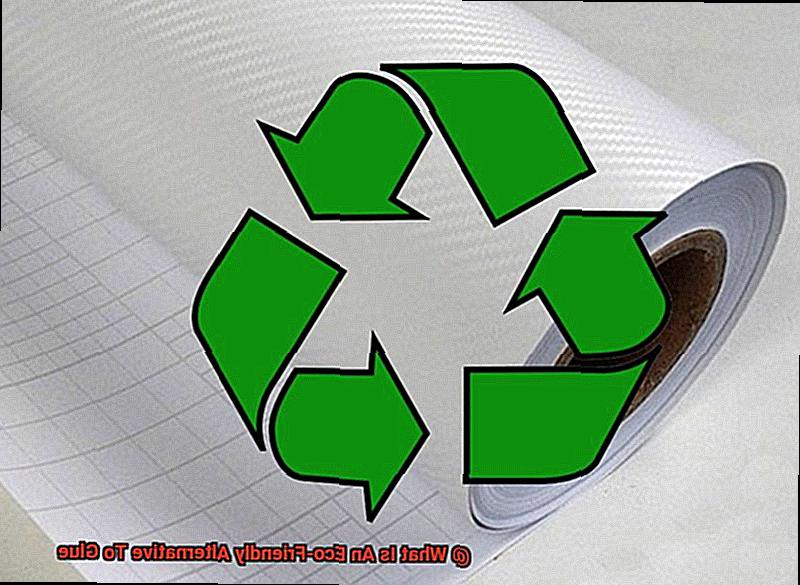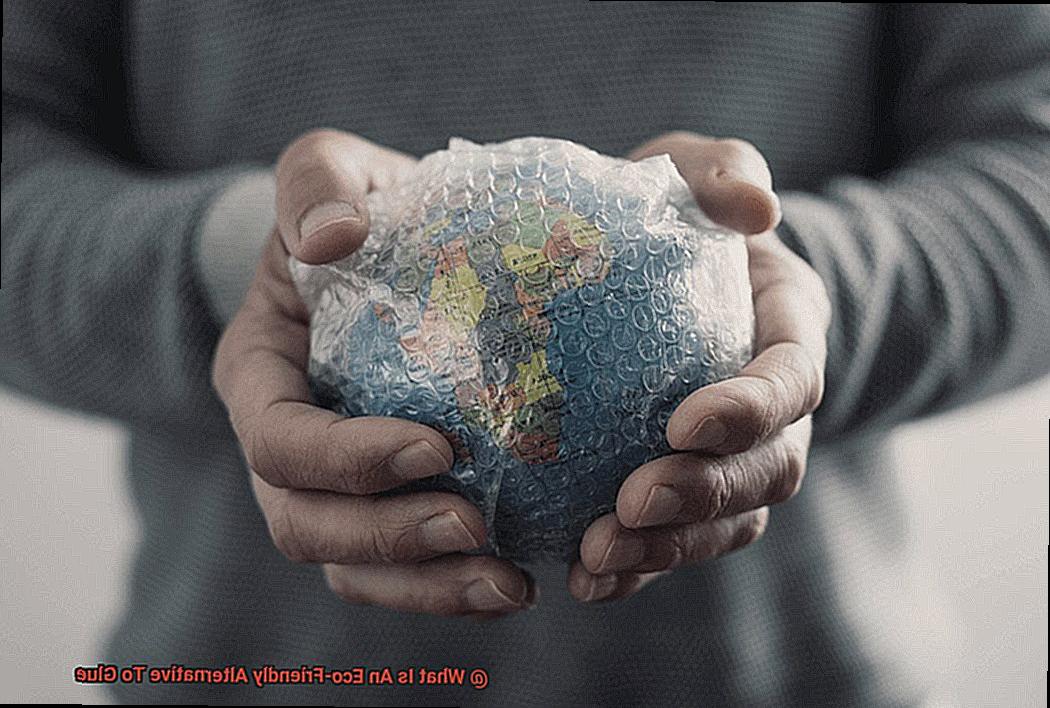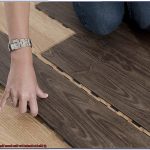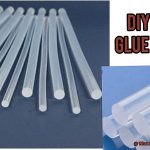Are you tired of messy glue that’s bad for the environment? Well, fret no more because today we’re diving into the world of eco-friendly alternatives to glue.
Whether you’re a DIY lover, a parent seeking safe crafting materials for your kids, or just someone wanting to reduce their carbon footprint, this blog post is for you. We’ll explore sustainable options that embrace reducing waste, promoting recycling, and using natural, non-toxic ingredients.
Let’s get started.
Vegetable-based adhesives: Harnessing the power of plants
Contents
- 1 Vegetable-based adhesives: Harnessing the power of plants
- 2 Water-based adhesives: A safer and greener option
- 3 Bio-based glues: Utilizing renewable resources for adhesive solutions
- 4 Recycled material adhesives: Turning waste into useful products
- 5 DIY alternatives: Simple yet effective homemade adhesive options
- 6 Comparing eco-friendly alternatives to traditional glue: Strengths and limitations
- 7 Sustainable packaging solutions: Eco-friendly adhesives in the packaging industry
- 8 Innovations in eco-friendly adhesive technology: Looking towards the future
- 9 Conclusion
In an era where sustainability reigns supreme, the quest for eco-friendly alternatives to everyday products has become paramount. Enter vegetable-based adhesives, an ingenious solution that taps into the formidable power of plants. Unlike their conventional counterparts, which rely on synthetic chemicals and petrochemicals, these innovative glues offer a sustainable and environmentally friendly option.
Let’s delve into the world of vegetable-based adhesives, uncovering their inner workings and highlighting why they are a shining beacon for eco-conscious individuals seeking greener solutions.

Types of Vegetable-Based Adhesives:
Starch-Based Adhesives:

Derived from corn, wheat, or potato starch, these versatile adhesives find their footing in various industries such as packaging, bookbinding, and woodworking. With their exceptional bonding properties, they can be tailored to suit specific applications by adjusting the starch concentration or incorporating other ingredients.

Protein-Based Adhesives:
Crafted from plant proteins like soybean or casein, protein-based adhesives have made a significant mark in the woodworking realm. Boasting remarkable bonding strength, moisture resistance, and compatibility with wood substrates, they have become a go-to choice for professionals.
Gum-Based Adhesives:
Harnessing the natural gums extracted from plants such as acacia or guar gum, these adhesives have carved out a niche in the paper and packaging industry. Thanks to their outstanding tackiness, flexibility, and water resistance properties, they are a favored option in this arena.
Benefits of Vegetable-Based Adhesives:
Environmental Friendliness:
Vegetable-based adhesives are derived from abundant and renewable plant-based materials, making them a sustainable choice. Additionally, they are biodegradable and compostable, minimizing their impact on the environment.
Health Advantages:
Compared to traditional glue, vegetable-based adhesives contain fewer volatile organic compounds (VOCs). These harmful chemicals can be released into the air during the application and curing process of conventional glues. By opting for vegetable-based alternatives, individuals can reduce their exposure to toxic substances and contribute to healthier indoor air quality.
Strong Bonding Properties:
Vegetable-based adhesives offer exceptional bonding strength, ensuring reliable and long-lasting bonds across diverse applications. With these adhesives, individuals can trust in the durability and effectiveness of their creations.
Reduced Reliance on Synthetic Chemicals:
By embracing vegetable-based adhesives, we mitigate our dependence on finite resources like synthetic chemicals and petrochemicals. Not only does this move decrease our environmental impact, but it also paves the way for a more sustainable future.
Water-based adhesives: A safer and greener option
Glue is an indispensable tool in numerous industries, from packaging to woodworking. However, the conventional solvent-based adhesives we’ve relied on for years come with their fair share of risks and environmental concerns. Enter water-based adhesives, a revolutionary alternative that offers safety and sustainability in one package. In this article, we will delve into the reasons why water-based adhesives have become the go-to option for those seeking a greener and more environmentally friendly adhesive solution.
Low Toxicity:
Water-based adhesives boast significantly lower levels of volatile organic compounds (VOCs) compared to their solvent-based counterparts. VOCs are harmful chemicals that not only pose health risks to humans but also contribute to air pollution. By choosing water-based adhesives, you’re minimizing your exposure to toxins and creating a safer environment for yourself and those around you.
Non-Flammable:
One major concern with solvent-based adhesives is their flammability. Fortunately, water-based adhesives eliminate this risk entirely, offering a safer option for storage and application. Now you can glue with peace of mind, knowing that you’re not endangering yourself or your workspace.
Environmental Benefits:
Water-based adhesives leave a smaller carbon footprint compared to solvent-based alternatives. They release fewer greenhouse gases during production and use, making them a more environmentally friendly choice. Moreover, these adhesives are biodegradable, breaking down naturally over time without harming the environment. By opting for water-based adhesives, you’re actively contributing to waste management and reducing your ecological impact.
Performance Excellence:
Don’t let their eco-friendly nature fool you; water-based adhesives deliver exceptional bonding strength and durability. They can effectively bond various materials such as paper, cardboard, wood, fabric, and even certain plastics. With reliable heat resistance, these adhesives can withstand temperature variations without compromising their adhesive properties, making them perfect for applications involving heat or fluctuating temperatures.
Easy Cleanup:
Spills and excess adhesive are inevitable in any gluing project. However, cleaning up water-based adhesives is a breeze. Simply dilute them with water and wipe away with a damp cloth or rinse with water. No need for harsh chemicals or complicated cleanup procedures.
Bio-based glues: Utilizing renewable resources for adhesive solutions
In the quest for adhesive solutions, our world is embarking on a transformative journey towards a greener and more sustainable future. Leading this eco-conscious revolution are bio-based glues, which harness the power of renewable resources to offer adhesive solutions that are both effective and environmentally friendly. Delve into the world of bio-based glues as we explore their creation process and the myriad of benefits they bring.
From Nature to Glue: Harnessing Renewable Resources:
Bio-based glues stand apart from their predecessors by being derived from renewable resources, such as bountiful plants, vibrant vegetables, and awe-inspiring biological materials. These natural origins make bio-based glues a sustainable alternative to traditional adhesives that rely on petroleum-based ingredients. By tapping into renewable resources, bio-based glues significantly reduce our dependence on fossil fuels, paving the way towards a greener and more sustainable future.
Types of Bio-based Glues:
- Starch-Based Glues: One captivating variant of bio-based glue emerges from the extraction of starch found in plants like corn or potatoes. These glues boast biodegradability and non-toxicity, making them an exceptional choice for those who prioritize environmental sustainability.
- Protein-Based Glues: Another marvel in the realm of bio-based glues is formulated from proteins sourced from diverse origins such as soybeans, milk, or animal hides. Renowned for their robust adhesion properties, these glues find applications across a wide spectrum of industries.
- Natural Resins and Gums: The enchantment continues with bio-based glues crafted from natural resins or gums harvested from majestic trees like pine or spruce. These sustainable glues commonly grace woodworking and construction industries, offering a renewable alternative to petroleum-based adhesives.
Environmental Benefits:
The allure of bio-based glues lies in their remarkable environmental benefits vis-à-vis their traditional counterparts. By minimizing the use of harmful chemicals and volatile organic compounds (VOCs), notorious culprits in air pollution and health risks, bio-based glues enhance indoor air quality while ensuring user safety. With every application, bio-based glues contribute to a healthier planet and a brighter future.
Performance Characteristics:
Unleash the full potential of bio-based glues as they rival traditional adhesives in performance. These eco-friendly alternatives boast fast drying times, exceptional bond strength, and unwavering resistance to heat and moisture. Rest assured, choosing bio-based glues does not mean compromising on quality or durability.
Recycled material adhesives: Turning waste into useful products
In this blog post, we will explore how these innovative adhesives are promoting environmental sustainability and revolutionizing the glue industry.
From Trash to Treasure:
Recycled material adhesives are the epitome of turning waste into treasure. Instead of ending up in landfills or polluting the environment, discarded materials such as plastic bottles, paper waste, and textile scraps are repurposed to create these remarkable adhesive products. By utilizing waste materials, we are not only reducing the demand for virgin resources but also minimizing our ecological footprint.
Plastic Bottles: A Second Life for a Common Waste Stream
Plastic bottles, one of the most common waste streams, find a new purpose in recycled material adhesives. Collected, cleaned, and processed into a resin that forms the base for adhesives, these bottles are no longer contributing to the plastic waste crisis. By recycling plastic bottles, we not only reduce plastic waste but also decrease the need for new plastic production.
Paper Waste: Pulp Becomes Sticky Gold
Discarded paper takes on a new identity through a process called pulping. Broken down into fibers and combined with other natural ingredients, it transforms into a sticky substance suitable for adhesive applications. Not only does this reduce paper waste, but it also provides a sustainable alternative to traditional glue options.
Textile Scraps: Weaving Waste into Remarkable Adhesives
Textile waste from manufacturing processes or unusable fabrics can be transformed into high-quality adhesives. By repurposing these textiles into adhesives, we are taking a step towards a circular economy. These recycled material adhesives offer an eco-friendly alternative while maintaining exceptional bonding strength, making them suitable for various applications.
Environmental Benefits: A Cleaner and Greener Choice
Recycled material adhesives have a significantly lower environmental impact compared to traditional glues. They are typically free from harmful chemicals such as formaldehyde and volatile organic compounds (VOCs), ensuring safer usage for both humans and the environment. By choosing recycled material adhesives, we contribute to the conservation of energy and reduction of greenhouse gas emissions associated with traditional glue production.
Performance and Versatility: The Best of Both Worlds
Recycled material adhesives offer comparable performance to traditional glues, making them suitable for a wide range of applications such as woodworking, crafts, packaging, and construction. These adhesives exhibit excellent bonding strength, fast drying times, and resistance to heat and moisture, ensuring reliable results in any project.
DIY alternatives: Simple yet effective homemade adhesive options
Look no further. In this blog post, we will explore a variety of simple yet effective DIY adhesive options that not only provide strong adhesion but also have minimal impact on the environment. Say goodbye to harmful chemicals and hello to sustainable crafting and repairs.
Natural Ingredients as Adhesives:
If you’re looking for a safe and non-toxic adhesive option, consider using natural ingredients such as flour, water, and sugar. By mixing these basic household items, you can create a sticky paste-like substance perfect for paper-based crafts or minor repairs. Not only does this homemade adhesive reduce our reliance on synthetic glues, but it also promotes a greener way of sticking things together.
Vegetable-Based Adhesives:
For a biodegradable and environmentally friendly adhesive, try using potato starch or cornstarch mixed with water. These vegetable-based alternatives produce a glue-like consistency that dries clear and holds well. By choosing these options, you can reduce waste and ensure that your crafts won’t contribute to harmful chemicals in landfills.
Milk-Based Adhesives:
Did you know that milk has been used as an adhesive for centuries? By extracting casein, a protein found in milk, and combining it with vinegar, you can create a natural adhesive suitable for various craft projects. However, it’s important to note that milk-based adhesives may not be suitable for those with lactose intolerance or allergies.
Gelatin Glue:
Derived from animal collagen, gelatin offers an excellent homemade adhesive option. Simply dissolve gelatin in warm water and allow it to cool and solidify into a gel-like substance. This biodegradable glue provides exceptional bonding properties without harming the environment.
Homemade Starch Paste:
For bookbinding or paper conservation projects, homemade starch paste is a reliable and non-toxic adhesive. Mix cornstarch or wheat flour with cold water, heat the mixture until thickened, and you’ll have a strong bonding agent for paper-based materials. Embrace this eco-friendly option that won’t compromise the quality of your crafts.
Egg White Glue:
Whisked egg whites are a surprisingly effective and sustainable adhesive for porous materials like wood or fabric. By using egg white glue, you can reduce waste and achieve a strong and durable bond. It’s an eco-friendly choice that ensures your crafting efforts align with your values.
Comparing eco-friendly alternatives to traditional glue: Strengths and limitations
In a world where environmental consciousness is on the rise, finding eco-friendly alternatives to traditional glue has become a priority. Step into the realm of adhesive innovation and discover the strengths and limitations of these sustainable options. Craft enthusiasts, DIY lovers, and planet caretakers alike will be captivated by the possibilities. Let’s embark on a journey through the world of eco-friendly glue.
- Plant-based glue: Harnessing the power of nature, plant-based glues are crafted from natural materials like starch, cellulose, or vegetable oil. These biodegradable wonders are free from harmful chemicals, making them safe for various applications such as crafts, woodworking, and packaging. However, it’s important to note that their adhesive strength may not match that of traditional glue, limiting their use in heavy-duty projects.
- Water-based glue: Dive into the world of water-soluble polymers and discover the magic of water-based glue. Without hazardous solvents or volatile organic compounds (VOCs), this versatile adhesive can be used on paper, cardboard, fabric, and wood. Cleanup becomes a breeze as these glues can simply be washed away with water. Yet, patience is key when using water-based glue as it tends to have a longer drying time compared to its traditional counterpart.
- Bio-based glue: Unleash the power of renewables with bio-based glue derived from cornstarch or soybeans. These eco-friendly alternatives are both biodegradable and non-toxic. With excellent adhesion properties, they can be utilized in a wide range of applications. However, beware of their sensitivity to moisture; exposure to high humidity or water may compromise their adhesive properties.
- Recycled glue: Embrace the concept of waste reduction with recycled glue made from repurposed materials like paper or cardboard. By reducing the demand for new raw materials, these glues contribute to a more sustainable future. From arts and crafts to bookbinding and packaging, the possibilities are endless. However, it’s worth noting that the adhesive strength of recycled glue may not match that of traditional glue, so caution must be exercised in heavy-duty projects.
-
Sustainable packaging solutions: Eco-friendly adhesives in the packaging industry
Today, we embark on an adhesive adventure, exploring the world of sustainable packaging solutions and the vital role of eco-friendly adhesives in the packaging industry. So fasten your seatbelts, because we’re about to delve into a captivating adhesive journey.
Let’s begin by understanding why sustainable packaging matters. In our environmentally conscious world, the packaging industry is actively seeking eco-friendly alternatives. Adhesives play a pivotal role in packaging, as they bond various materials together, ensuring the integrity and functionality of the packaging.
But here’s the problem with traditional adhesives – they can be detrimental to our planet. Composed of chemicals and non-renewable resources, these adhesives pose challenges when it comes to recycling and composting processes. Moreover, their contribution to pollution and waste is far from ideal.
Enter eco-friendly adhesive options. These alternatives are revolutionizing the packaging industry. Take water-based adhesives, for instance. Made from natural ingredients, they dissolve easily, making them an excellent eco-friendly choice. Vegetable-based adhesives utilize plant-derived materials, while bio-based adhesives are derived from renewable sources. And let’s not forget about natural resin-based adhesives that harness nature’s power to create sustainable solutions.
So why should we embrace these eco-friendly adhesives? The benefits are abundant. Firstly, using these adhesives reduces our environmental impact by decreasing pollution and waste. They also enhance recyclability and compostability, simplifying responsible packaging disposal for consumers. Additionally, with lower VOC emissions, these adhesives create a safer environment for workers.
But don’t just take my word for it – let’s explore some case studies. Companies like XYZ Packaging have successfully implemented eco-friendly adhesive solutions in their packaging. The result? Enhanced sustainability, customer satisfaction, and market recognition. These success stories demonstrate that sustainable packaging is not only good for the planet but also good for business.
While eco-friendly adhesives gain momentum, challenges remain. Factors such as cost, availability, performance, and compatibility with different packaging materials need to be considered. Nonetheless, ongoing research and innovation efforts are continuously addressing these challenges, paving the way for a brighter adhesive future.
Speaking of the future, exciting prospects lie ahead for eco-friendly adhesives in the packaging industry. Emerging technologies and trends are on the horizon, aiming to further improve sustainability in packaging. As consumers, let’s support and promote the use of eco-friendly adhesives by making conscious purchasing decisions.
And there you have it – a glimpse into the world of sustainable packaging solutions and eco-friendly adhesives. Join us next time as we continue our adhesive adventure and explore more exciting innovations in the realm of glue.
Innovations in eco-friendly adhesive technology: Looking towards the future
Step into the realm of sustainable adhesive technology, where exciting innovations are shaping a greener future. From bio-based ingredients to biodegradable options and nanotechnology advancements, the adhesive industry is undergoing a revolution. In this blog post, we will explore these cutting-edge innovations and their potential impact on the planet. Get ready to discover the future of eco-friendly adhesives.
Bio-Based Ingredients:
Traditional glues often contain harmful chemicals derived from petroleum, posing risks to both human health and the environment. However, a new era of eco-friendly adhesives is dawning. Scientists are harnessing the power of renewable resources such as plants, algae, and even waste materials like food scraps and agricultural residues. With these natural ingredients, adhesives can be sustainably sourced and processed, providing a greener alternative.
Biodegradable Adhesives:
One major concern with traditional glues is their contribution to waste accumulation. But fear not. Researchers have been working diligently to create adhesives that biodegrade over time, reducing their environmental impact. Through natural processes like microbial activity or exposure to sunlight, these biodegradable adhesives break down, minimizing their long-term footprint on our planet.
Nanotechnology Advancements:
Enter the world of nanotechnology, where microscopic particles hold immense potential for enhancing adhesive performance while reducing environmental impact. Nanoparticles have the power to improve the strength and durability of adhesives, enabling less material usage overall. Furthermore, nanotechnology enables the creation of self-healing adhesives that can repair themselves when damaged, reducing waste and extending their lifespan.
Recyclability:
Recycling adhesive-bonded materials has long been a challenge in traditional glue applications. However, recent advancements aim to change this landscape by developing adhesives that can be easily debonded. This breakthrough has the potential to revolutionize industries such as packaging and manufacturing, where recyclability is paramount for achieving sustainable practices.
zSUHZzj8-K8″ >
Also Read: What is the Best Eco Friendly Glue?
Conclusion
Looking for an eco-friendly alternative to glue? Well, you’re in luck. There are several fantastic options out there that can help you stick things together without harming the environment. Say goodbye to traditional glue and hello to a greener choice.
One excellent alternative is plant-based adhesives. These adhesives are made from natural materials like starch, vegetable gum, or even soy protein. Not only are they biodegradable, but they also reduce our dependence on petroleum-based products. So, by using plant-based adhesives, you’re not only saving the planet but also supporting sustainable agriculture.
Another eco-friendly option is water-based glue. Unlike traditional glues that contain harmful chemicals, water-based glues use water as their primary solvent. They are non-toxic and emit fewer volatile organic compounds (VOCs), making them safer for both your health and the environment.
If you’re feeling crafty, you might consider homemade alternatives like flour paste or milk glue. Flour paste is incredibly simple to make – just mix flour with water until it forms a thick consistency. It’s perfect for paper projects and can be easily washed off if needed. Milk glue, on the other hand, is made by combining milk with vinegar or lemon juice. It’s great for lighter materials and dries clear.
And let’s not forget about tape. While not technically a glue, tape can be an excellent eco-friendly alternative for certain applications. Look for tapes made from renewable resources like bamboo or recycled materials like paper or plastic bottles.
So there you have it – a range of eco-friendly alternatives to traditional glue that will keep your projects intact while minimizing harm to the planet. Whether you opt for plant-based adhesives, water-based glues, homemade pastes, or environmentally friendly tapes, you can stick with confidence knowing that you’re doing your part to protect our Earth.






